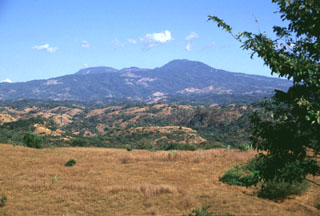Report on Tecapa (El Salvador) — May 1985
Scientific Event Alert Network Bulletin, vol. 10, no. 5 (May 1985)
Managing Editor: Lindsay McClelland.
Tecapa (El Salvador) Earthquake swarm at historically inactive volcano
Please cite this report as:
Global Volcanism Program, 1985. Report on Tecapa (El Salvador) (McClelland, L., ed.). Scientific Event Alert Network Bulletin, 10:5. Smithsonian Institution. https://doi.org/10.5479/si.GVP.SEAN198505-343080
Tecapa
El Salvador
13.494°N, 88.502°W; summit elev. 1593 m
All times are local (unless otherwise noted)
"An earthquake swarm occurred by surface faulting on 21 April in the Chinameca Complex, near Tecapa, a volcano with no known historic eruption. A magnitude 4.7 (mb) earthquake, the largest so far, occurred on 23 April . . . . Four days later, 27 April, during the peak activity (in terms of numbers of recorded and felt events per day), an 8 km-long graben formed on the NW flank of the volcano. The N40°W-striking graben is 0.8-1 km wide, with a vertical offset of 30 cm. Through 6 June, 170 earthquakes were felt in the area. A very preliminary analysis of the earthquake location data implies that activity began on a tectonic fault some 15 km NW of the volcanic summit, and moved nearer to the volcano at the time the graben formed. Since 3 June, 5-20 earthquakes per day were recorded by a high-gain seismograph station 50 km from the volcano, down from 300 events per day on 26, 27, and 28 April, and 21 and 23 May."
Geological Summary. Tecapa is a complex basaltic-to-andesitic stratovolcano at the NW end of a cluster of volcanoes E of the Río Lempa between San Vicente and San Miguel volcanoes. The Berlín caldera, whose rim is visible on the W side of the complex, was formed during the eruption of the Blanca-Rosa dacitic pumice in the late Pleistocene. Following caldera formation, the cones of Cerro Las Palmas, Cerro Pelón, Tecapa-Laguna de Alegria, and Cerro Alegria were constructed along a WSW-ENE line. The crater of Tecapa-Laguna de Alegria contains a deep notch on the eastern rim and is filled by Laguna de Alegria crater lake. The volcanic complex currently displays fumarolic activity, and a producing geothermal plant is located at the Berlín geothermal field.
Information Contacts: J. González, Centro de Investigaciones Geotécnicas, San Salvador; D. Harlow, USGS.

